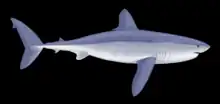Megalolamna
Megalolamna is an extinct genus of lamniform shark that belongs to the family Otodontidae. Its name comes from the similarity of its teeth to those of the extant shark genus Lamna. It is known from the early Miocene Chilcatay Formation of Peru, Oi and O'oshimojo Formations of Japan, and the Jewett Sand Formation of California and Pungo River Formation, North Carolina in the United States, implying a cosmopolitan distribution. The largest specimen is estimated to have measured about 5.1 metres (17 ft) long.[1]
| Megalolamna Temporal range: Early to Mid Miocene ~ | |
|---|---|
 | |
| Fossil teeth from the Dos Bocas Formation, Ecuador | |
| Scientific classification | |
| Domain: | Eukaryota |
| Kingdom: | Animalia |
| Phylum: | Chordata |
| Class: | Chondrichthyes |
| Order: | Lamniformes |
| Family: | †Otodontidae |
| Genus: | †Megalolamna |
| Species: | †M. paradoxodon |
| Binomial name | |
| †Megalolamna paradoxodon Shimada et al., 2016 | |
Taxonomy
It is considered to be the sister genus of Otodus. The study of Megalolamna's taxonomic relationships also demonstrates the possibility that Otodus needs to include the species sometimes assigned to Carcharocles (i.e., the megatoothed lineage, including megalodon) in order to be monophyletic.[1]
References
- Shimada, K.; Chandler, R. E.; Lam, O. L. T.; Tanaka, T.; Ward, D. J. (2016-10-03). "A new elusive otodontid shark (Lamniformes: Otodontidae) from the lower Miocene, and comments on the taxonomy of otodontid genera, including the 'megatoothed' clade". Historical Biology. 29 (5): 704–714. doi:10.1080/08912963.2016.1236795. ISSN 0891-2963.
